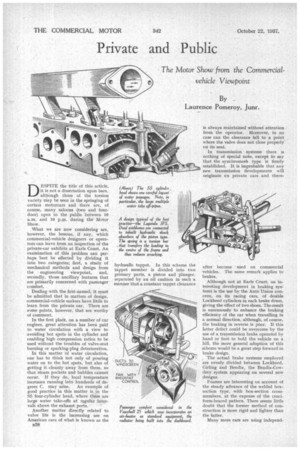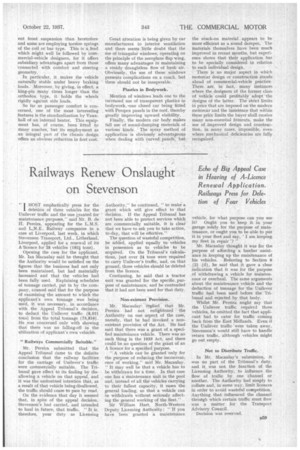Private and Public
Page 80

Page 81

If you've noticed an error in this article please click here to report it so we can fix it.
The Motor Show from the Commercialvehicle Viewpoint
By .
Laurence Pomeroy, Junr.
DESPITE the title of this article, it is not a dissertation upon bars, although those of the torsion variety May be seen in the springing of certain motorcars and there are, of course, many saloons (two and fourdoor) open to the public between 10 a.m. and 10 p.m. during the Motor Show.
What we are now considering are, however, the lessons, if any, which commercial-vehicle designers or operators can learn from an inspection of the private-car exhibits at Earls Court, An examination of this problem can perhaps. best be effected by dividing it into two categories; first, a study of mechanical methods and design from the engineering viewpoint, and, secondly, those ancillary features that are primarily concerned with passenger comfort.
Dealing with the first-named, it must be admitted that in matters of design, commercial-vehicle makers have little to learn from the private car. There are some points, however, that are worthy of comment.
In the first place, on a number of car engines, great attention has been paid to water circulation with a view to avoiding hot spots in the cylinder and enabling high compression ratios to be used without the troubles of valve-seat burning or sparking-plug deterioration.
In this matter of water circulation, one has to think not only of pouring water on to the hot spots, but also of getting it cleanly away from them, so that 'steam pockets and bubbles cannot occur. If they do,. local temperature increases running into hundreds of degrees C. may arise. An example of good practice in this matter is in the SS four-cylinder head, where there are large water take-offs at regular intervals above the exhaust ports.
Another matter directly related to valve life is the increasing use on American cars of what is known as the B58 hydraulic tappet. In this scheme the tappet member is divided into two primary parts, a piston and plunger, separated by an oil cushion in such a manner that a constant tappet clearance is always maintained without attention from the operator. Moreover, in no case can the clearance fall to a point where the valve does not close properly on its seat.
In transmission systems there is nothing of special note, except to say that the synchromesh type is firmly established. It is improbable that any new transmission developments will originate on private cars and there after become used on commercial vehicles. The same remark applies to brakes.
Although not at Earls Court, an interesting development in braking systems is the use by the Auto Union concern, on its racing cars, of double Lockheed cylinders in each brake drum, giving the effect of two shoes. The result is enormously to enhance the braking efficiericy of the car when travelling in a normal direction, although, of course, the braking in reverse is poor. If this latter defect could be overcome by the use of a transmission brake operated by hand or foot to hold the vehicle on a hill, the more general adoption of this scheme would be a great step forward in brake design.
The actual brake systems employed are evenly divided between Lockheed, Girling and Bendix, the Bendix-Cowdrey system appearing on several new designs.
Frames are interesting on account of the steady advance of the welded boxsection type, with box-section crossmembers, at the expense of the cruciform-braced pattern. There seems little doubt that the former method of construction is more rigid and lighter than the latter.
Many more cars are using independ eat front suspension than heretofore and some are employing torsion springs of the coil or bar type. This is alead which might well be followed by corninercial-vehicle designers, for it offers subsidiary advantages apart from those connected with comfort and steering geometry,
In particular, it makes the vehicle naturally stable under heavy braking loads. Moreover, by giving, in effect, a king-pin many. times longer than the orthodox type, it holds the wheels rigidly against side loads.
So far as passenger comfort is concerned, one of the most interesting features is the standardization by Vauxhall of an internal heater. This equipment has, of course, been fitted to many coaches, hut its eniployment as an integral part of the Chassis design offers an obvious reduction in first cost. Great attention is being given by car manufacturers to interior ventilation and there seems little doubt that the use of triangular windows, operating on the principle of the aeroplane flap wing, offers many advantages in maintaining a steady draughtless flow of fresh air. Obviously, the use of these windows presents complications on a coach, but these should not be insuperable.
Plastics in Bodywork.
• Mention of windows leads one to the increased use of transparent plastics in bodywork, one closed car being fitted with Perspex panels in the roof, thereby greatly improving upward visibility.
Finally, the modern car body makes full use of sound-damping materials of various kinds. The spray method of application is obviously advantageous when dealing with curved. panel's, but the stuck-on material, appears to be more efficient as a sound damper. The materials themselves have been much improved in recent months, but experience shows that their application has to be specially considered in relation to each individual design.
There is no major aspect in which motorcar design or construction stands ahead of commercial-vehicle practice. There are, in fact, many instances where the designers of the former class of vehicle could profitably adopt the designs of the latter. The strict limits in price that are imposed on the modern motorcar and the insistence that within these pride limits the buyer shall receive many non-essential fitments, make the use of improved design and construction, in many cases, impossible, even where mechanical deficiencies are fully recognized. ' •
























































































































